Reviews
Review: Total War: Shogun 2
April 26, 2011, Author: Giuseppe Nelva
More than ten years ago, the real-time strategy genre was still budding. It was back in the summer of 2000 that Starcraft took the world by storm to become one of the most popular games of the history of our hobby but in the same month of July, basically back-to-back with Blizzard’s giant, another strategy game, slower paced but no less interesting, was released by Creative Assembly. It was Shogun: Total War. Despite not reaching the massive popularity of Blizzard’s early masterpiece, Shogun managed to carve for itself a very strong niche of followers and enthusiasts, that still lives and thrives to this day.
It’s also not surprising that the success of the first title spawned sequels, with the Total War series exploring history from the middle ages to the Napoleonic wars, through three different publishers, and a lot of awesome user-created mods. After all those years, it was only natural for the Creative Assembly to revisit their origins, going back to the Sengoku Jidai; the Japanese “period of the country at war”, with Total War: Shogun 2.
Back to the Origins
The Sengoku Jidai was a period of bloody civil war between warlords (or Daimiyo) that set ablaze the Japanese archipelago for about a century and a half, starting in the middle of 15th century.
While the Ashikaga Shogunate still was, in name, ruling from Kyoto, every province was basically under the independent government of a different Daimiyo, creating a fragmentation of power that could only lead to open warfare lined by countless acts of subterfuge and open political struggle. This, quite obviously, makes for the perfect setting for a Total War game.
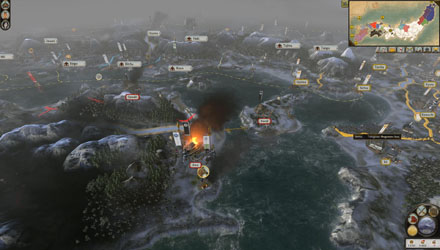
Japan is torn by war, as smoke billows from sieged castles.
The Player takes controls the Daimiyo of one of the ten most prominent clans that ruled Japan at the time. The number of eligible clans is reduced to nine unless you buy the collector or the limited editions of the game, but there’s still plenty room for choice. In any case, the range of options is probably going to increase radically in the future, since the availability of minor factions is normally the first thing that gets modded in every Total War game.
The objective is simple: take control of a large portion of the Japanese territory (how large depends on the campaign settings) and conquer Kyoto to become the new Shogun.
A “tighter” Total War
As soon as you launch the game, you’re welcomed by a clear divide between single player and multiplayer options. The single player modes are the usual for a game of this series. Custom battles allow you to choose every combination of troops and terrain for a quick brawl with no consequences.
Historical battles are more involved, featuring complex scenarios with full narration and scripted events, fought over purposely-designed maps that can prove quite compelling, even if their longevity is obviously limited, especially due to the small number of scenarios.
You will be able to fight three famous land-based battles and a single naval one. A fourth land battle is available only to those that pre-ordered the game at Gamestop. By the way, did I ever write how much I hate content-related preorder exclusives for single retailers? I can understand and support some purely cosmetic bonuses, but here we’re talking about game content actually present on the disk that everyone buys, but that can be enjoyed only by those that chose (or were forced to) bring their money to one particular shop. I’m sure I’m not the only one that thinks this is quite nonsensical and an extremely annoying business practice, but I guess I’m digressing…
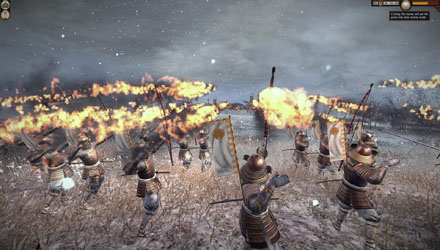
Fire and snow meet on the field of battle...
The heart of the single player gameplay remains in the campaign, like in previous TW titles. Three different campaign modes are available, with the only difference being the duration and the number of regions that the player will have to conquer (in addition to Kyoto) to view the final victory screen. Many could feel this a little redundant, considering that it’s possible to continue playing past the end date whether you have won or lost, so the only real difference is in when, and if, you’ll see a short movie telling you that you won or not.
There are also five levels of difficulty ranging from easy to legendary that should be able to satisfy most players’ personal preferences in challenge. Unlike previous Total War games, the option to select campaign and battle difficulty separately isn’t present during the selection of the campaign itself, but you can change the battle difficulty dynamically during the game. This is quite the welcome option, considering that many novice players could find out that they bit off more than they can chew, or the other way around.
The choice between the ten (or nine) aforementioned major clans is mostly defined by their starting position and by their military attitudes. Each clan is specialized in certain aspects of warfare; be it cavalry, archery, sword-fighting and so forth. The starting position is a quite determining factor in the difficulty at the start of the campaign, as some of the clans (like the Shimazu) start with their back covered by the sea, while others (like the Oda) have to move their first shaky steps surrounded by enemies aiming for their blood.
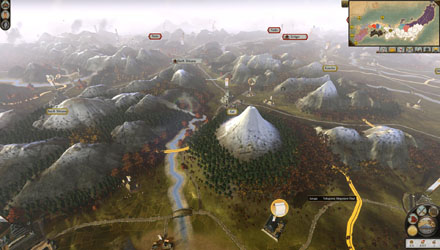
The Fujiyama looms over the war-torn Japanese valleys...
As soon as the campaign starts you will be shown just your small corner of Japan in full 3D, while the rest will be represented by a 2D map that will turn 3D as you explore it. The beginning is pretty much akin to the standard of the strategy genre, with a single castle (two, in the case of the Hojo clan, specialized in siege warfare), a handful of soldiers and a big bunch of dreams of glory and triumph.
The map immediately reveals one of the weaknesses of the game; the Japanese archipelago has been split in the provinces historically present after the Meiji restoration (almost three centuries in the future), but historical inaccuracy aside, the flaw is purely functional. With Japan split in such large areas, each clan starts with just one province, with absolutely no initial buffer between their lightly protected capital and the aforementioned bloodthirsty enemies. This will result in a campaign losing a large percentage of the clans, both major and minor in the first ten or twenty turns of the game.
I was personally overjoyed when I first heard that the game would feature a large amount of clans between the playable ones and the AI-only ones, because it promised a wider variety and more complex diplomacy and intrigue. Unfortunately the joy was dulled immediately as soon as I started my first campaign, and saw a large amount of those clans wiped out from the map before I could even get near enough to encounter them. When you play as the Tokugawa clan and see your Oda arch-enemies and neighbors, not to mention one of the major historical players of the Sengoku Jidai, wiped out during the very first turn by another nearby clan before you even had the chance to set foot in their territory, you can’t help thinking that something is seriously amiss.
Considering that battles in the Sengoku Jidai were basically fought village by village, and not region by region, and taking in account the fact that Japan isn’t exactly that big of a country, a map with a larger scale, with provinces split in a larger number of areas each built around a village (with only the capital featuring a castle) would have brought forth a more fluid gameplay, a more variety in the campaign, and more survivability for the clans. Still, moving beyond the initial disappointment for this detail, that would probably influence more strategy games enthusiasts like me; used to extremely detailed maps and complex attacks and counter-attacks, instead of just “walk in region, conquer region, enemy obliterated”, the number of clans on the map in itself is a great asset to the game, providing some much-needed longevity and variety.
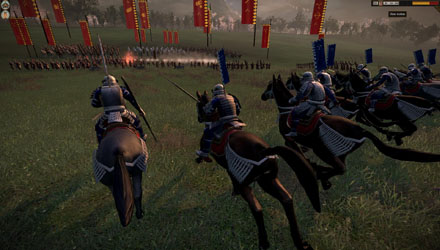
Taking revenge for The Last Samurai...
The campaign game itself presents the player with a lovely wealth of options, almost comparable to the deepest strategy-only games out there. Of course, a complexity similar to Europa Universalis would be too much, and probably would require too many resources for a game that remains a hybrid between turn-based strategy and real-time tactics. Shogun 2, though, manages to get quite near to masterpieces like the Civilization series, giving the player that sensation of control needed to avoid feeling that the strategy part is an afterthought or an accessory.
A welcome addition to the formula of the most recent Total War games is the management of food sources that keeps the player away from the temptation of simply building every available option without giving some thought from the consequences. If you start seeing riots because your peasants don’t have anything to eat, it means that you built your castles too big, or that you have too many markets and the food isn’t going to your population.
The list of buildings you can use to enrich your castles is wide and varied, and goes from military uses like various dojo to train several types of samurai, to civilian utilities like temples to speed up research and markets. You cannot build everything in each city, and that’s a sound choice, because just as the food-related limitations, it adds another level of depth to the game, prompting the player to specialize each castle to prosper.
An important change from the previous two games, Empire and Napoleon is the return of a feature that was a personal favourite of mine in Medieval 2: the family tree. In Shogun 2 you’ll be able to administer your clan not only from a military point of view, but you’ll also be able to survey and influence the growth of the daimiyo’s family; decide who will be the heir, marry your sons to princesses from other clans or to the daughters of your retainers to strengthen your bloodline and your alliances and so forth. It’s a very interesting part of the game because it gives your generals more depth and makes them feel more like living and breathing entities instead of just pawns to move around the battlefield and sacrifice at will.
The family tree feature is linked strongly to the new RPG elements introduced by Creative Assembly in Shogun 2. Now every general and agent will earn experience like in a RPG game, and the player will be able to assign traits on a dedicated skill tree, allowing for more customization and specialization of those characters. There will still be some random traits coming from various situations (for instance generals that are left too long in a city tend to become a tad too appreciative of the graces of the local geisha), but most of the times the player will be much more in control of the growth of his most trusted men than in previous Total War games. A little detail I appreciated quite a lot is the inclusion of different models for agents that reached the top level. Your most experienced Ninja will look fearsome with body armor and an Oni mask.
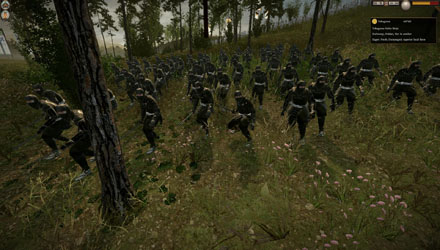
Ninja!
Talking about agents, an old favourite of Total War enthusiasts, there are four types. Ninja are your spies and assassins, Metsuke are counter-spies, and are able to boost your tax income. Monks and Missionaries (depending on your religion) can perform a variety of tasks, from inciting rebellions in enemy regions to eliminating enemy agents by converting them and act on the morale of troops on the battlefield. Geishas are basically ninja on steroids, but lack the ability to move around with stealth. All agents can move and perform missions on their own, be stationed in your city with a range of beneficial effects, or accompany an army to boost its strength in various ways.
While agents are often a lot of fun to use, they tend to be, in my opinion, really overpowered, especially when leveled up. A six stars monk in combination with a couple of ninja can easily become a game winner, as you’re able to cherry pick a region you like, wait for the enemy troops to move away from the castle, effortlessly paralyze the army and move in with your monk to incite a rebellion. The result is that you’ll have a nice, ripe region for the taking against relatively weak rebels, without even needing to declare war on the previous owner.
Diplomacy options have received a bit of an overhaul with a couple of new options, like the ability to exchange hostages with other factions, and the decisions of the AI factions seem to make slightly more sense than in previous Total War games. At least most of the time. One of the most improved aspects, for instance, is that vassal clans will now be very eager to join wars on your side, instead of keeping an overly neutral stance.
This is, unfortunately, quite tarnished by one of the worst flaws of the game, the Realm Divide mechanic. Creative Assembly received a sizable amount of criticism on their previous games on how easy to beat the AI was, so they decided to use a rather annoying placebo. As soon as you conquer your fifteenth province, the Realm Divide will trigger, but it won’t really follow its namesake. The realm won’t in fact be split in two even slightly comparable parts, as this mechanic applies a growing relation negative modifier with every single faction of the game, turning even your most trusted allied into bloodthirsty wolves hunting for your heart. Not only this is completely illogical, but it utterly obliterates two important aspects of the game, diplomacy and commerce, turning the campaign in a much duller and variety-lacking slugfest. I understand that the game is named “Total war”, but diplomacy and commerce add a lot of longevity and variety, and without them everything becomes just a sequence of battles that tend to become boring faster.
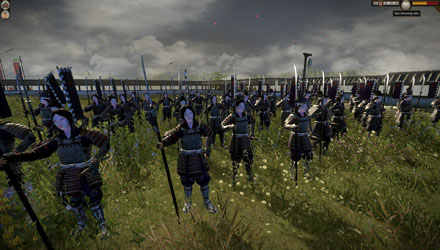
Weak gender? Yeah, sure....
Another disappointing aspect of the diplomacy game is the removal of the ability to exchange provinces with the AI factions. This completely takes away the tools from the player’s hand to actually take care of his allies, giving them back the regions they lose to enemies, and helping them grow. If one of your allies is attacked by a superior force, either you have an army in the immediate vicinity to protect them, or you won’t have a chance to give them back what land they’ll happen to lose. You can still try to support their attacks, in the (often quite misplaced) hope that they will manage to take back the lost regions by themselves, but this still forces the player to go through inconvenient and time-consuming loopholes that could be easily replaced by a simple option, that was already present and working perfectly in previous Total War games.
When diplomacy fails, though (and due to the aforementioned reasons it will fail a lot), war remains the only option, and a quite beefy option at that. Building up massive armies of brave samurai is as satisfying as ever, even thanks to the many units available to all clans, that give the player the ability to really customize his army according to his own style. The only negative point is the absolute lack of faction-specific units, that tends to reduce longevity and replayability. Every faction on the field, in fact, will field exactly the same kind of troops, just painted a different color and wearing different flags. This is a radical step back from previous Total War games, in which disparities between the unit roster given to each different nation were quite evident.
Creative Assembly explained that annoying standardization with the fact that the factions in the game “belong all to the same culture”, but the excuse doesn’t really hold much water. Japan has always been a country with strong cultural and geographical differences, and that reflected upon warfare quite radically. The Japanese military tradition and history are rich enough to warrant for some more variation, as special units for each clan could have easily been implemented, especially considering that Creative Assembly doesn’t seem to have many qualms in implementing units of semi-fantasy inspiration. In game development, when there’s a will there’s a way. Too bad that, unfortunately, the will seemed to be rather lacking in this aspect.
Pages: 1 2 3Platforms: PC | Tagged Creative Assembly, PC, review, RTS, Samurai, Sega, Steam, Strategy, Total War: Shogun 2, Windows



